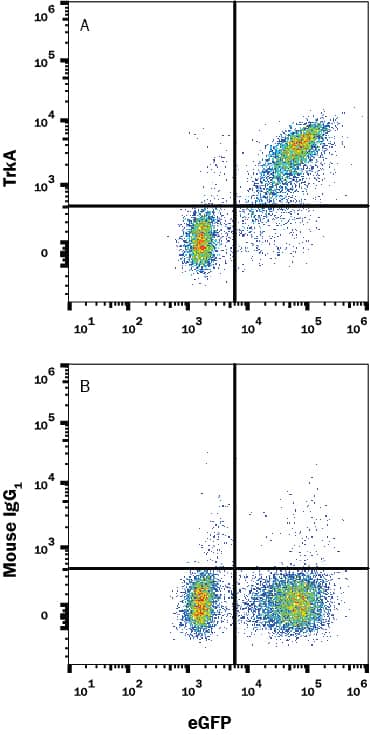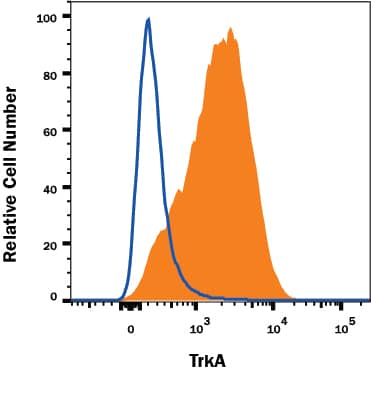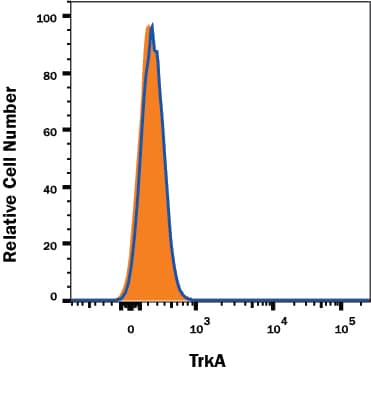Human TrkA Antibody
R&D Systems, part of Bio-Techne | Catalog # MAB1751R


Key Product Details
Validated by
Species Reactivity
Validated:
Cited:
Applications
Validated:
Cited:
Label
Antibody Source
Product Specifications
Immunogen
Ala33-Glu407
Accession # P04629
Specificity
Clonality
Host
Isotype
Scientific Data Images for Human TrkA Antibody
Detection of TrkA in BAF Cell Line Transfected with Human TrkA and eGFP by Flow Cytometry.
BAF cell line transfected with human TrkA and eGFP was stained with (A) Mouse Anti-Human TrkA Monoclonal Antibody (Catalog # MAB1751R) or (B) Mouse IgG1 isotype control antibody (Catalog # MAB002) followed by APC-conjugated Anti-Mouse IgG Secondary Antibody (Catalog # F0101B). View our protocol for Staining Membrane-associated Proteins.Detection of TrkA in K562 Human Cell Line by Flow Cytometry.
K562 human chronic myelogenous leukemia cell line was stained with Mouse Anti-Human TrkA Monoclonal Antibody (Catalog # MAB1751R, filled histogram) or isotype control antibody (Catalog # MAB002, open histogram) followed by APC-conjugated Anti-Mouse IgG Secondary Antibody (Catalog # F0101B). View our protocol for Staining Membrane-associated Proteins.TrkA is specifically detected in K562 human chronic myelogenous leukemia cell line parental cell line but is not detectable in TrkA knockout K562 cell line.
TrkA knockout K562 human chronic myelogenous leukemia cell line was stained with Mouse Anti-Human TrkA Monoclonal Antibody (Catalog # MAB1751R, filled histogram) or isotype control antibody (Catalog # MAB002, open histogram) followed by APC-conjugated Anti-Mouse IgG Secondary Antibody (Catalog # F0101B). No staining in the TrkA knockout K562 cell line was observed. View our protocol for Staining Membrane-associated Proteins.Applications for Human TrkA Antibody
CyTOF-ready
Flow Cytometry
Sample: BAF Cell Line Transfected with Human TrkA and eGFP
Knockout Validated
Formulation, Preparation, and Storage
Purification
Reconstitution
Formulation
Shipping
Stability & Storage
- 12 months from date of receipt, -20 to -70 °C as supplied.
- 1 month, 2 to 8 °C under sterile conditions after reconstitution.
- 6 months, -20 to -70 °C under sterile conditions after reconstitution.
Background: TrkA
TrkA, the product of the proto-oncogene trk, is a member of the neurotrophic tyrosine kinase receptor family that has three members. TrkA, TrkB, and TrkC preferentially bind NGF, NT-4 and BDNF, and NT-3, respectively. All Trk family proteins share a conserved complex subdomain organization consisting of a signal peptide, two cysteine-rich domains, a cluster of three leucine-rich motifs, and two immunoglobulin-like domains in the extracellular region, as well as an intracellular region that contains the tyrosine kinase domain. Two distinct TrkA isoforms that differ by virtue of a 6-amino acid insertion in their extracellular domain have been identified. The longer TrkA isoform is the only isoform expressed within neuronal tissues whereas the shorter TrkA is expressed mainly in non-neuronal tissues. NGF binds to TrkA with low affinity and activates its cytoplasmic kinase, initiating a signaling cascade that mediates neuronal survival and differentiation. Higher affinity binding of NGF requires the coexpression of TrkA with the p75 NGF receptor (NGF R), a member of the tumor necrosis factor receptor superfamily. NGF R binds all neurotrophins with low affinity and modulates Trk activity as well as alters the specificity of Trk receptors for their ligands. NGF R can also mediate cell death when expressed independent of Trk.
References
- Esposito, D. et al. (2001) J. Biol. Chem. 276:32687.
- Sofroniew, M.V. et al. (200) Annu. Rev. Neurosci. 24:1217.
Long Name
Alternate Names
Gene Symbol
UniProt
Additional TrkA Products
Product Documents for Human TrkA Antibody
Product Specific Notices for Human TrkA Antibody
For research use only

